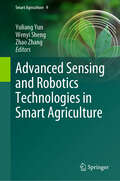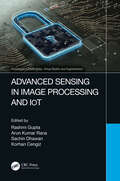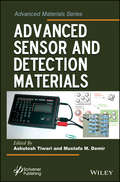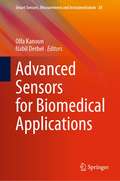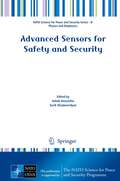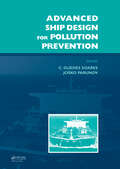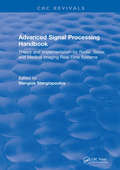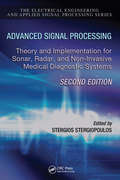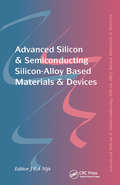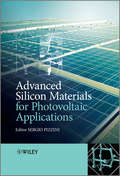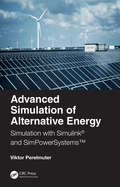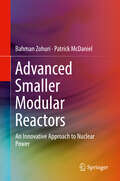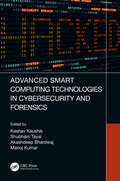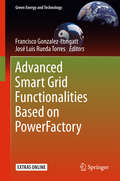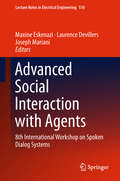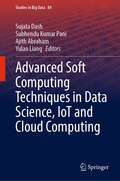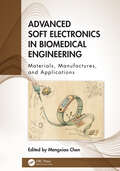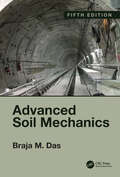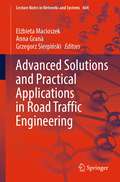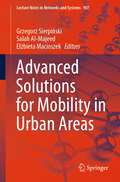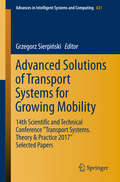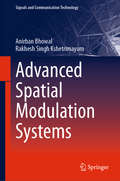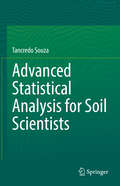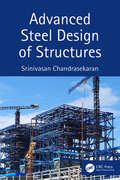- Table View
- List View
Advanced Sensing and Robotics Technologies in Smart Agriculture (Smart Agriculture #9)
by Zhao Zhang Wenyi Sheng Yuliang YunThis book specifically focuses on state-of-the-art advanced sensing and robotic techniques in smart agriculture and comprehensively describes the new knowledge. Significant agricultural technology progress in advanced sensing and robotics technology has been made recently, which has transformed the conventional agriculture to smart and digital agriculture It provides readers take-away knowledge for seed quality detection, specialty crop harvest and sorting robotics, new sensing method for crop nutrient status, and broadband soil dielectric permittivity measurements. All these new technologies have been developed, tested, or practically applied. It is a useful reference for readers in the field of smart agriculture and agriculture robotics.
Advanced Sensing in Image Processing and IoT (Innovations in Multimedia, Virtual Reality and Augmentation)
by Rashmi Gupta, Arun Kumar Rana, Sachin Dhawan, and Korhan CengizThe book provides future research directions in IoT and image processing based Energy, Industry, and Healthcare domain and explores the different applications of its associated technologies. However, the Internet of Things and image processing is a very big field with a lot of subfields, which are very important such as Smart Homes to improve our daily life, Smart Cities to improve the citizens' life, Smart Towns to recover the livability and traditions, Smart Earth to protect our world, and Industrial Internet of Things to create safer and easier jobs. This book considers very important research areas in Energy, Industry, and Healthcare domain with IoT and image processing applications.The aim of the book to highlights future directions of optimization methods in various engineering and science applications in various IoT and image processing applications. Emphasis is given to deep learning and similar models of neural network-based learning techniques employed in solving optimization problems of different engineering and science applications. The role of AI in mechatronics is also highlighted using suitable optimization methods. This book considers very important research areas in Energy, Industry, and Healthcare. It addresses major issues and challenges in Energy, Industry, and Healthcare and solutions proposed for IoT-enabled cellular/computer networks, routing/communication protocols, surveillances applications, secured data management, and positioning approaches. It focuses mainly on smart and context-aware implementations. Key sailing Features: The impact of the proposed book is to provide a major area of concern to develop a foundation for the implementation process of new image processing and IoT devices based on Energy, Industry, and Healthcare related technology. The researchers working on image processing and IoT devices can correlate their work with other requirements of advanced technology in Energy, Industry, and Healthcare domain. To make aware of the latest technology like AI and Machine learning in Energy, Industry, and Healthcare related technology. Useful for the researcher to explore new things like Security, cryptography, and privacy in Energy, Industry, and Healthcare related technology. People who want to start in Energy, Industry, and Healthcare related technology with image processing and IoT world.
Advanced Sensor and Detection Materials
by Ashutosh Tiwari Mustafa M. DemirThe development of sensors at macroscopic or nanometric scales in solid, liquid, or gas phases, contact or noncontact configurations, has driven the research of sensor & detection materials and technology into high gear. The emphasis on detection techniques requires the use of spin crossover organic, inorganic and composite materials and methods that could be unique for sensors fabrication. The influence of length, composition and conformation structure of materials on their properties and the possibilities to adjust sensing properties by doping or adding the side-groups are the starting point of multifarious sensing. The role of inter-molecular interactions, polymer and ordered phases formation, as well as the behavior under pressure, magnetic and electric fields are also important facts for processing of ultra-sensing materials. Advanced Sensor and Detection Materials highlights the key features that aid the design of new sensor and detection materials for a multitude of sensor and detection devices. The senior contributors write on the follow topics:Construction of nanostructuresThe role of the shape in the design of new nanoparticlesAdvances in sensors' nanotechnologyMolecularly imprinted polymer for enantioselective sensing devicesFerrites for high frequency applicationsMesoporous Silica: Making "Sense" of SensorsPorous TiO2-Au/Ag materialsFerroelectronic glass-ceramicsNASICON: Synthesis, structure and electrical characterisationHeavy clay products qualityIonic liquidsDendrimers and hyperbranched polymersTheoretical investigation of superconducting state parametersMicroscopic polarization and thermal conductivity of binary Wurtzite nitridesExperiments techniques and theoretical background to study materialsThe book is written for readers from diverse backgrounds across chemistry, physics, materials science and engineering, medical science, pharmacy, biotechnology, and biomedical engineering. It offers a comprehensive view of cutting-edge research on advanced materials for sensor and detection technology and applications.
Advanced Sensors for Biomedical Applications (Smart Sensors, Measurement and Instrumentation #38)
by Nabil Derbel Olfa KanounThe book highlights recent developments in the field of biomedical sensors with a focus on technology and design aspects of novel sensors and sensor systems. Diagnosis plays a central role in healthcare and requires a variety of novel biomedical sensors and sensor systems. This creates an enormous ongoing demand for sensors for both the everyday life as well as for medical care. Technologies concerning the analysis of human activities as well as for the early detection of diseases are moving into the focus of interest and form the basis for supporting human health and quality of life. As such, the book offers a key reference guide about novel medical sensors and systems for students, engineers, sensors designers and technicians.
Advanced Sensors for Safety and Security (NATO Science for Peace and Security Series B: Physics and Biophysics)
by Ashok Vaseashta Surik KhudaverdyanThis book results from a NATO Advanced Research Workshop titled "Technological Innovations in CBRNE Sensing and Detection for Safety, Security, and Sustainability" held in Yerevan, Armenia in 2012. The objective was to discuss and exchange views as to how fusion of advanced technologies can lead to improved sensors/detectors in support of defense, security, and situational awareness. The chapters range from policy and implementation, advanced sensor platforms using stand-off (THz and optical) and point-contact methods for detection of chemical, nuclear, biological, nuclear and explosive agents and contaminants in water, to synthesis methods for several materials used for sensors. In view of asymmetric, kinetic, and distributed nature of threat vectors, an emphasis is placed to examine new generation of sensors/detectors that utilize an ecosystems of innovation and advanced sciences convergence in support of effective counter-measures against CBRNE threats. The book will be of considerable interest and value to those already pursuing or considering careers in the field of nanostructured materials, and sensing/detection of CBRNE agents and water-borne contaminants. For policy implementation and compliance standpoint, the book serves as a resource of several informative contributions. In general, it serves as a valuable source of information for those interested in how nanomaterials and nanotechnologies are advancing the field of sensing and detection using nexus of advanced technologies for scientists, technologists, policy makers, and soldiers and commanders.
Advanced Ship Design for Pollution Prevention
by Joško Parunov C. Guedes SoaresAdvanced Ship Design for Pollution Prevention is a collection of papers reflecting the teaching materials for a Master of Naval Architecture course developed in the European ASDEPP (Advanced Ship Design for Pollution Prevention) project. The project was financed by the European Commission within the TEMPUS program.The topics covered in the book inc
Advanced Signal Processing Handbook: Theory and Implementation for Radar, Sonar, and Medical Imaging Real Time Systems (CRC Press Revivals)
by Thomas J. WebsterAdvances in digital signal processing algorithms and computer technology have combined to produce real-time systems with capabilities far beyond those of just few years ago. Nonlinear, adaptive methods for signal processing have emerged to provide better array gain performance, however, they lack the robustness of conventional algorithms. The challenge remains to develop a concept that exploits the advantages of both-a scheme that integrates these methods in practical, real-time systems.The Advanced Signal Processing Handbook helps you meet that challenge. Beyond offering an outstanding introduction to the principles and applications of advanced signal processing, it develops a generic processing structure that takes advantage of the similarities that exist among radar, sonar, and medical imaging systems and integrates conventional and nonlinear processing schemes.
Advanced Signal Processing: Theory and Implementation for Sonar, Radar, and Non-Invasive Medical Diagnostic Systems, Second Edition (Electrical Engineering & Applied Signal Processing Series)
by Stergios StergiopoulosDiscover the Applicability, Benefits, and Potential of New Technologies As advances in algorithms and computer technology have bolstered the digital signal processing capabilities of real-time sonar, radar, and non-invasive medical diagnostics systems, cutting-edge military and defense research has established conceptual similarities in these areas. Now civilian enterprises can use government innovations to facilitate optimal functionality of complex real-time systems. Advanced Signal Processing details a cost-efficient generic processing structure that exploits these commonalities to benefit commercial applications. Learn from a Renowned Defense Scientist, Researcher, and Innovator The author preserves the mathematical focus and key information from the first edition that provided invaluable coverage of topics including adaptive systems, advanced beamformers, and volume visualization methods in medicine. Integrating the best features of non-linear and conventional algorithms and explaining their application in PC-based architectures, this text contains new data on: Advances in biometrics, image segmentation, registration, and fusion techniques for 3D/4D ultrasound, CT, and MRI Fully digital 3D/ (4D: 3D+time) ultrasound system technology, computing architecture requirements, and relevant implementation issues State-of-the-art non-invasive medical procedures, non-destructive 3D tomography imaging and biometrics, and monitoring of vital signs Cardiac motion correction in multi-slice X-ray CT imaging Space-time adaptive processing and detection of targets interference-intense backgrounds comprised of clutter and jamming With its detailed explanation of adaptive, synthetic-aperture, and fusion-processing schemes with near-instantaneous convergence in 2-D and 3-D sensors (including planar, circular, cylindrical, and spherical arrays), the quality and illustration of this text’s concepts and techniques will make it a favored reference.
Advanced Silicon & Semiconducting Silicon-Alloy Based Materials & Devices
by Johan F A NijsOne of the first books to cover advanced silicon-based technologies, Advanced Silicon and Semiconducting Silicon Alloy-Based Materials and Devices presents important directions for research into silicon, its alloy-based semiconducting devices, and its development in commercial applications. The first section deals with single/mono crystalline silicon, focusing on the effects of heavy doping; the structure and electronic properties of defects and their impact on devices; the MBE of silicon, silicon alloys, and metals; CVD techniques for silicon and silicon germanium; the material properties of silicon germanium strained layers; silicon germanium heterojunction bipolar applications; FETs, IR detectors, and resonant tunneling devices in silicon, silicon germanium, and d-doped silicon; and the fascinating properties of crystalline silicon carbide and its applications. The second section explores polycrystalline silicon. It examines large grain polysilicon substrates for solar cells; the properties, analysis, and modeling of polysilicon TFTs; the technology of polysilicon TFTs in LCD displays; and the use of polycrystalline silicon and its alloys in VLSI applications. With contributors from leading academic and industrial research centers, this book provides wide coverage of fabrication techniques, material properties, and device applications.
Advanced Silicon Materials for Photovoltaic Applications
by Sergio PizziniToday, the silicon feedstock for photovoltaic cells comes from processes which were originally developed for the microelectronic industry. It covers almost 90% of the photovoltaic market, with mass production volume at least one order of magnitude larger than those devoted to microelectronics.However, it is hard to imagine that this kind of feedstock (extremely pure but heavily penalized by its high energy cost) could remain the only source of silicon for a photovoltaic market which is in continuous expansion, and which has a cumulative growth rate in excess of 30% in the last few years. Even though reports suggest that the silicon share will slowly decrease in the next twenty years, finding a way to manufacture a specific solar grade feedstock in large quantities, at a low cost while maintaining the quality needed, still remains a crucial issue. Thin film and quantum confinement-based silicon cells might be a complementary solution.Advanced Silicon Materials for Photovoltaic Applications has been designed to describe the full potentialities of silicon as a multipurpose material and covers:Physical, chemical and structural properties of siliconProduction routes including the promise of low cost feedstock for PV applicationsDefect engineering and the role of impurities and defectsCharacterization techniques, and advanced analytical techniques for metallic and non-metallic impuritiesThin film silicon and thin film solar cellsInnovative quantum effects, and 3rd generation solar cellsWith contributions from internationally recognized authorities, this book gives a comprehensive analysis of the state-of-the-art of process technologies and material properties, essential for anyone interested in the application and development of photovoltaics.
Advanced Simulation of Alternative Energy: Simulation with Simulink® and SimPowerSystems™
by Viktor M. PerelmuterAdvanced Simulation of Alternative Energy: Simulations with Simulink® and SimPowerSystems™ considers models of new and promising installations of renewable energy sources, as well as the new trends in this technical field. The book is focused on wind generators with multiphase generators, models of different offshore parks, wind shear and tower shadow effect, active damping, system inertia support, synchronverter modeling, photovoltaic cells with cascaded H-Bridge multilevel inverters, operation of fuel cells with electrolyzers and microturbines, utilization of ocean wave and ocean tide energy sources, pumped storage hydropower simulation, and simulation of some hybrid systems. Simulink® and its toolbox, SimPowerSystems™ (its new name Electrical/Specialized Power Systems), are the most popular means for simulation of these systems. More than 100 models of the renewable energy systems that are made with use of this program environment are appended to the book. The aims of these models are to aid students studying various electrical engineering fields including industrial electronics, electrical machines, electrical drives, and production and distribution of electrical energy; to facilitate the understanding of various renewable energy system functions; and to create a platform for the development of systems by readers in their fields. This book can be used by engineers and investigators as well as undergraduate and graduate students to develop new electrical systems and investigate the existing ones.
Advanced Smaller Modular Reactors: An Innovative Approach to Nuclear Power
by Bahman Zohuri Patrick McDanielThis book discusses advanced Small Modular Reactors (SMRs) as a way to provide safe, clean, and affordable nuclear power options. The advanced SMRs currently under development in the U.S. represent a variety of sizes, technology options and deployment scenarios. These advanced reactors, envisioned to vary in size from a couple megawatts up to hundreds of megawatts can be used for power generation, process heat, desalination, or other industrial uses. In-depth chapters describe how advanced SMRs offer multiple advantages, such as relatively small size, reduced capital investment, location flexibility, and provisions for incremental power additions. SMRs also offer distinct safeguards, security and nonproliferation advantages. The authors present a thorough examination of the technology and defend methods by which the new generation of nuclear power plants known as GEN-IV can safely be used as an efficient source of renewable energy. Provides a unique and innovative approach to the implementation of Small Modular Reactor as part of GEN-IV technology; Discusses how Small Modular Reactors (SMRs) can deliver a viable alternative to Nuclear Power Plants (NPPs);Presents an argument defending the need for nuclear power plant as a source of energy, its efficiency and cost effectiveness, as well as safety related issues.
Advanced Smart Computing Technologies in Cybersecurity and Forensics
by Manoj Kumar Akashdeep Bhardwaj Shubham Tayal Keshav KaushikThis book addresses the topics related to artificial intelligence, the Internet of Things, blockchain technology, and machine learning. It brings together researchers, developers, practitioners, and users interested in cybersecurity and forensics. The first objective is to learn and understand the need for and impact of advanced cybersecurity and forensics and its implementation with multiple smart computational technologies. This objective answers why and how cybersecurity and forensics have evolved as one of the most promising and widely-accepted technologies globally and has widely-accepted applications. The second objective is to learn how to use advanced cybersecurity and forensics practices to answer computational problems where confidentiality, integrity, and availability are essential aspects to handle and answer. This book is structured in such a way so that the field of study is relevant to each reader’s major or interests. It aims to help each reader see the relevance of cybersecurity and forensics to their career or interests. This book intends to encourage researchers to develop novel theories to enrich their scholarly knowledge to achieve sustainable development and foster sustainability. Readers will gain valuable knowledge and insights about smart computing technologies using this exciting book. This book: • Includes detailed applications of cybersecurity and forensics for real-life problems • Addresses the challenges and solutions related to implementing cybersecurity in multiple domains of smart computational technologies • Includes the latest trends and areas of research in cybersecurity and forensics • Offers both quantitative and qualitative assessments of the topics Includes case studies that will be helpful for the researchers Prof. Keshav Kaushik is Assistant Professor in the Department of Systemics, School of Computer Science at the University of Petroleum and Energy Studies, Dehradun, India. Dr. Shubham Tayal is Assistant Professor at SR University, Warangal, India. Dr. Akashdeep Bhardwaj is Professor (Cyber Security & Digital Forensics) at the University of Petroleum & Energy Studies (UPES), Dehradun, India. Dr. Manoj Kumar is Assistant Professor (SG) (SoCS) at the University of Petroleum and Energy Studies, Dehradun, India.
Advanced Smart Grid Functionalities Based on PowerFactory (Green Energy And Technology)
by Francisco Gonzalez-Longatt José Luis Rueda TorresThis book consolidates some of the most promising advanced smart grid functionalities and provides a comprehensive set of guidelines for their implementation/evaluation using DIgSILENT Power Factory. It includes specific aspects of modeling, simulation and analysis, for example wide-area monitoring, visualization and control, dynamic capability rating, real-time load measurement and management, interfaces and co-simulation for modeling and simulation of hybrid systems. It also presents key advanced features of modeling and automation of calculations using PowerFactory, such as the use of domain-specific (DSL) and DIgSILENT Programming (DPL) languages, and utilizes a variety of methodologies including theoretical explanations, practical examples and guidelines. Providing a concise compilation of significant outcomes by experienced users and developers of this program, it is a valuable resource for postgraduate students and engineers working in power-system operation and planning.
Advanced Social Interaction with Agents: 8th International Workshop on Spoken Dialog Systems (Lecture Notes in Electrical Engineering #510)
by Maxine Eskenazi Joseph Mariani Laurence DevillersThis book presents lectures given at the 8th International Workshop on Spoken Dialog Systems. As agents evolve in terms of their ability to carry on a dialog with users, several qualities are emerging as essential components of a successful system. Users do not carry on long conversations on only one topic—they tend to switch between several topics. Thus the authors are observing the emergence of multi-domain systems that enable users to seamlessly hop from one domain to another. The systems have become active social partners. Accordingly, work on social dialog has become crucial to active and engaging human–robot/agent interaction. These new systems call for a coherent framework that guides their actions as chatbots and conversational agents. Human–Robot/Agent assessment mechanisms naturally lend themselves to this task. As these systems increasingly assist humans in a multitude of tasks, the ethics of their existence, their design and their interaction with users are becoming crucial issues. This book discusses the essential players and features involved, such as chat-based agents, multi-domain dialog systems, human–robot interaction, social dialog policy, and advanced dialog system architectures.
Advanced Soft Computing Techniques in Data Science, IoT and Cloud Computing (Studies in Big Data #89)
by Ajith Abraham Sujata Dash Subhendu Kumar Pani Yulan LiangThis book plays a significant role in improvising human life to a great extent. The new applications of soft computing can be regarded as an emerging field in computer science, automatic control engineering, medicine, biology application, natural environmental engineering, and pattern recognition. Now, the exemplar model for soft computing is human brain. The use of various techniques of soft computing is nowadays successfully implemented in many domestic, commercial, and industrial applications due to the low-cost and very high-performance digital processors and also the decline price of the memory chips. This is the main reason behind the wider expansion of soft computing techniques and its application areas. These computing methods also play a significant role in the design and optimization in diverse engineering disciplines. With the influence and the development of the Internet of things (IoT) concept, the need for using soft computing techniques has become more significant than ever. In general, soft computing methods are closely similar to biological processes than traditional techniques, which are mostly based on formal logical systems, such as sentential logic and predicate logic, or rely heavily on computer-aided numerical analysis. Soft computing techniques are anticipated to complement each other. The aim of these techniques is to accept imprecision, uncertainties, and approximations to get a rapid solution. However, recent advancements in representation soft computing algorithms (fuzzy logic,evolutionary computation, machine learning, and probabilistic reasoning) generate a more intelligent and robust system providing a human interpretable, low-cost, approximate solution. Soft computing-based algorithms have demonstrated great performance to a variety of areas including multimedia retrieval, fault tolerance, system modelling, network architecture, Web semantics, big data analytics, time series, biomedical and health informatics, etc. Soft computing approaches such as genetic programming (GP), support vector machine–firefly algorithm (SVM-FFA), artificial neural network (ANN), and support vector machine–wavelet (SVM–Wavelet) have emerged as powerful computational models. These have also shown significant success in dealing with massive data analysis for large number of applications. All the researchers and practitioners will be highly benefited those who are working in field of computer engineering, medicine, biology application, signal processing, and mechanical engineering. This book is a good collection of state-of-the-art approaches for soft computing-based applications to various engineering fields. It is very beneficial for the new researchers and practitioners working in the field to quickly know the best performing methods. They would be able to compare different approaches and can carry forward their research in the most important area of research which has direct impact on betterment of the human life and health. This book is very useful because there is no book in the market which provides a good collection of state-of-the-art methods of soft computing-based models for multimedia retrieval, fault tolerance, system modelling, network architecture, Web semantics, big data analytics, time series, and biomedical and health informatics.
Advanced Soft Electronics in Biomedical Engineering: Materials, Manufactures, and Applications
by Mengxiao ChenThe book presents the latest advances in soft electronics in biomedical engineering and its potential applications in various biomedical fields.The contributors provide comprehensive coverage of how soft electronics are used in diagnostics and monitoring, medical therapy, neural engineering, and wearable and implantable systems. In particular, some emerging research areas such as advanced soft robotics, fiber sensing technologies, and power optimization strategies are explored. In addition, the book highlights international standardization activities in wearable technologies and implantable bioelectronics.The book will benefit researchers, engineers, and advanced students in biomedical engineering, electrical and computer engineering, and materials science.
Advanced Soil Mechanics, Fifth Edition
by Braja M. DasNow in its fifth edition, this classic textbook continues to offer a well-tailored resource for beginning graduate students in geotechnical engineering. Further developing the basic concepts from undergraduate study, it provides a solid foundation for advanced study. This new edition addresses a variety of recent advances in the field and each section is updated. Braja Das particularly expands the content on consolidation, shear strength of soils, and both elastic and consolidation settlements of shallow foundations to accommodate modern developments. New material includes: Recently published correlations of maximum dry density and optimum moisture content of compaction Recent methods for determination of preconsolidation pressure A new correlation for recompression index Different approaches to estimating the degree of consolidation A discussion on the relevance of laboratory strength tests to field conditions Several new example problems This text can be followed by advanced courses dedicated to topics such as mechanical and chemical stabilization of soils, geo-environmental engineering, critical state soil mechanics, geosynthetics, rock mechanics, and earthquake engineering. It can also be used as a reference by practical consultants.
Advanced Solutions and Practical Applications in Road Traffic Engineering (Lecture Notes in Networks and Systems #604)
by Elżbieta Macioszek Grzegorz Sierpiński Anna GranàThis book presents many valuable tips for making decisions related to traffic flow in transport networks. The knowledge base in practical examples, as well as the decision support systems described in this book, finds interest among people who face the daily challenge of searching for advanced solutions and practical applications in road traffic engineering. The publication is therefore addressed to local authorities related to the planning and development of development strategies for selected areas with regard to transport (both in the urban and regional dimension) and to representatives of business and industry, as people directly involved in the implementation of traffic engineering solutions.The publication contains selected papers submitted to and presented at the 18th “Transport Systems. Theory and Practice” Scientific and Technical Conference organized by the Department of Transport Systems, Traffic Engineering and Logistics at the Faculty of Transport and Aviation Engineering at the Silesian University of Technology. The conference took place on September 19-20, 2022, in Katowice (Poland).
Advanced Solutions for Mobility in Urban Areas (Lecture Notes in Networks and Systems #907)
by Elżbieta Macioszek Grzegorz Sierpiński Salah Al-MajeedThis book gathers selected papers presented at the 19th “Transport Systems. Theory and Practice” Scientific and Technical Conference organised by the Department of Transport Systems, Traffic Engineering and Logistics at the Faculty of Transport and Aviation Engineering of the Silesian University of Technology. How to ensure effectiveness and reduce risk in urban public transport? What factors have an influence on activity-travel participation? What is the future of electromobility in the context of decisions to buy electric vehicles? How to support tourists travelling by people with special needs? This publication provides you with answers to these and many other questions. It also contains an abundance of numerical analyses based on significant data sets, illustrating the close affiliation between mobility and quality of life. With regard to the research results discussed and the selected solutions applied, the book primarily addresses the needs of three target groups:• Scientists and researchers (ITS field).• Local authorities (responsible for the transport systems at the urban and regional level).• Representatives of business (traffic strategy management) and industry (manufacturers of ITS components).The conference was held on 18–19 September 2023 in Katowice (Poland).
Advanced Solutions in Power Systems: HVDC, FACTS, and Artificial Intelligence
by Mircea Eremia Abdel-Aty Edris Chen-Ching LiuProvides insight on both classical means and new trends in the application of power electronic and artificial intelligence techniques in power system operation and control This book presents advanced solutions for power system controllability improvement, transmission capability enhancement and operation planning. The book is organized into three parts. The first part describes the CSC-HVDC and VSC-HVDC technologies, the second part presents the FACTS devices, and the third part refers to the artificial intelligence techniques. All technologies and tools approached in this book are essential for power system development to comply with the smart grid requirements. Discusses detailed operating principles and diagrams, theory of modeling, control strategies and physical installations around the world of HVDC and FACTS systems Covers a wide range of Artificial Intelligence techniques that are successfully applied for many power system problems, from planning and monitoring to operation and control Each chapter is carefully edited, with drawings and illustrations that helps the reader to easily understand the principles of operation or application Advanced Solutions in Power Systems: HVDC, FACTS, and Artificial Intelligence is written for graduate students, researchers in transmission and distribution networks, and power system operation. This book also serves as a reference for professional software developers and practicing engineers.
Advanced Solutions of Transport Systems for Growing Mobility: 14th Scientific and Technical Conference "Transport Systems. Theory & Practice 2017" Selected Papers (Advances in Intelligent Systems and Computing #631)
by Grzegorz SierpińskiWhat are the parameters that should be taken into account in an advanced simulation model designed for a transport system that promotes green travelling policies? How can the goal of modal shift be pursued through ICT solutions? Is it enough to apply only a single criterion when planning transport systems? What is the importance of information acquisition and provision in Intelligent Transport Systems? Answers to these and many other questions can be found in this publication. It also contains numerous analyses based on relevant data sets, illustrating the close relationship between ITS and the changes observed in terms of how specific means of transport are used. What proves to be particularly important for advanced transport systems is the use of environmentally friendly solutions that reduce their negative environmental impacts; accordingly, the book also addresses this aspect. With regard to the research results discussed and the selected solutions applied, the book primarily addresses the needs of three target groups: #65533; Scientists and researchers (ITS field) #65533; Local authorities (responsible for transport systems at the urban and regional level) #65533; Representatives of business (traffic strategy management) and industry (manufacturers of ITS components) Advanced Solutions of Transport Systems for Growing Mobility gathers selected papers presented at the 14th "Transport Systems. Theory and Practice" Scientific and Technical Conference, organized by the Department of Transport Systems and Traffic Engineering at the Faculty of Transport of the Silesian University of Technology. The conference was held on 18-20 September 2017 in Katowice (Poland). More details at www. TSTP. polsl. pl
Advanced Spatial Modulation Systems (Signals and Communication Technology)
by Rakhesh Singh Kshetrimayum Anirban BhowalThis state-of-the-art book deals with advanced spatial modulation (ASM), which are a special class of recent Multiple-Input Multiple-Output MIMO techniques, for various applications like radio frequency (RF) based body area network (BAN) communication, free-space optical (FSO) communication, underwater optical wireless communication (UOWC) and hybrid FSO/RF communication. The performance analysis of such systems is achieved in terms of certain performance metrics and compared with other techniques available in the literature. Such SM based schemes can find its application in advanced 5G and 6G communications. The diagrams of the system models of the different schemes along with tables and examples will help readers get a clear understanding of this approach. This book elucidates required derivations, examples, and links various concepts related to this field so that readers can gain comprehensive knowledge. Pseudo codes or algorithms or MATLAB/MATHEMATICA programs are also provided so that readers can easily implement the concepts which they learn. This volume will be useful for students, researchers, and industry alike.
Advanced Statistical Analysis for Soil Scientists
by Tancredo SouzaIn the evolving field of soil science, advanced statistical analysis has become essential for understanding complex soil processes. Handbook of Advanced Statistical Analysis Applied offers a comprehensive guide to modern statistical methods such as PERMANOVA, ANOSIM, PCA, NMDS, RDA, and SEM, tailored specifically for soil science research.Through practical examples and case studies, the book demonstrates how these techniques can be applied to analyze complex datasets, identify patterns, and model interactions within soil ecosystems. It provides step-by-step guidance on data preparation, analysis, and interpretation, making it a valuable resource for students, early-career researchers, and professionals in soil science. By combining theoretical foundations with practical applications, Handbook of Advanced Statistical Analysis Applied presentes analytical tools needed to conduct rigorous research, contribute to scientific knowledge, and address challenges in sustainable land management. This book serves as a critical resource for mastering advanced statistical approaches in soil science.
Advanced Steel Design of Structures
by Srinivasan ChandrasekaranAdvanced Steel Design of Structures examines the design principles of steel members under special loads and covers special geometric forms and conditions not typically presented in standard design books. It explains advanced concepts in a simple manner using numerous illustrative examples and MATLAB® codes. Features: Provides analysis of members under unsymmetrical bending Includes coverage of structures with special geometry and their use in offshore applications for ultra-deep water oil and gas exploration Presents numerical modeling and analysis of steel members under fire conditions, impact, and blast loads Includes MATLAB® examples that will aid in the capacity building of civil engineering students approaching this complex subject Written for a broad audience, the presentation of design concepts of steel members will be suitable for upper-level undergraduate students. The advanced design theories for offshore structures under special loads will be an attractive feature for post-graduate students and researchers. Practicing engineers will also find the book useful, as it includes numerous solved examples and practical tutorials.
